Finding the best diet for your Golden Retriever is a key step in ensuring the health and well-being of your furry companion, whether you’re welcoming a Golden Retriever into your home for the first time or you’re a seasoned dog owner looking to refine your pet’s nutrition.
The best diet for Golden Retrievers includes high-quality proteins, healthy fats, essential vitamins, and minerals. Add fiber from vegetables and fruits like berries for digestion. You should tailor a balanced diet to their age and activity level.
This guide will provide you with the essential information on Golden Retriever nutrition. From understanding their unique dietary needs to choosing foods they’ll love, we’ll help you navigate the path to a happy and healthy dog.
Let’s get started!
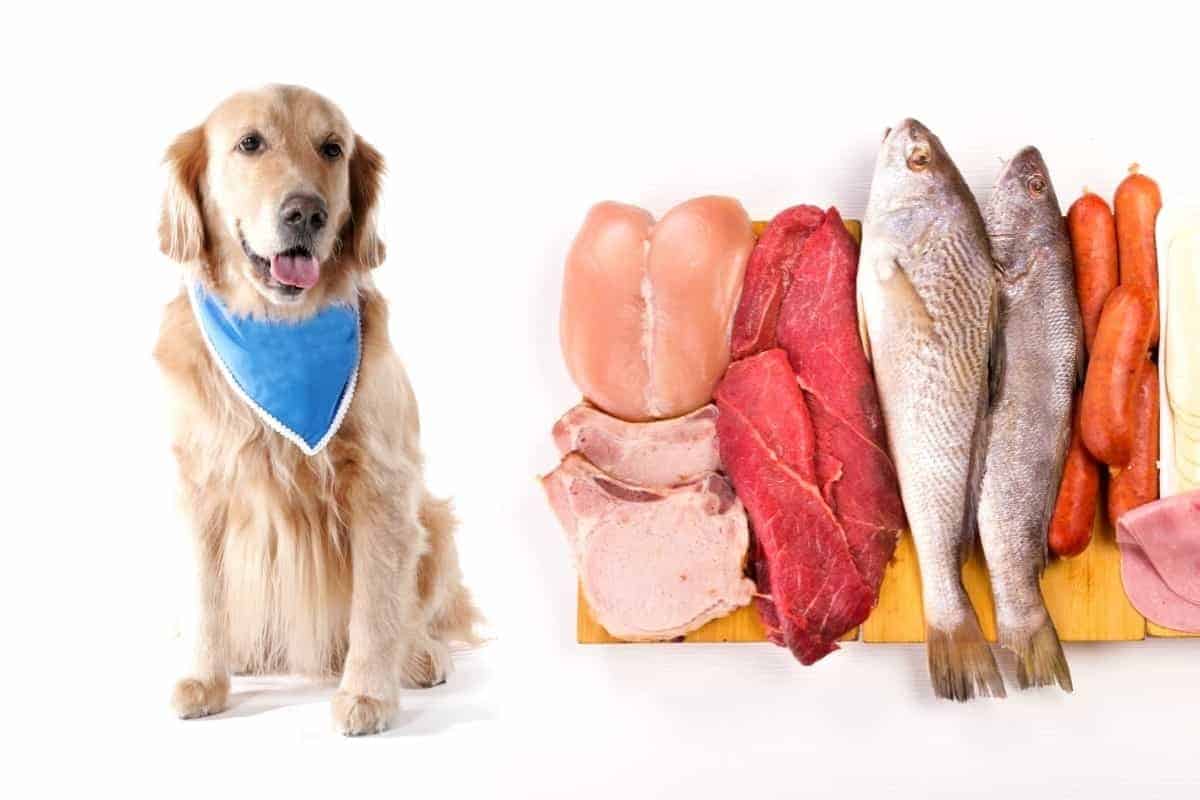
Nutritional Requirements for Golden Retrievers
As the variety of dog foods continues to grow, you may wonder how you know if you’re providing your beloved dog with all his nutritional needs.
Before we head on, understand that:
- Goldens need a balanced diet that should be regularly assessed by a vet to avoid malnutrition.
- Homemade food is the best, but you can also mix commercial dry/wet food to improve eating portions.
Golden Retrievers need many different kinds of nutrients to survive. These are:
- Proteins, fats, and carbohydrates
- Vitamins and minerals
- Water
The nutritional profile of all commercial dog foods must be consistent with the guidelines established by the AAFCO (Association of American Feed Control Officials), which declares what can be used in pet foods.
The MSD Vet Manual also publishes profiles of dog nutrients. It has tons of detail and even lists all the vitamins and minerals your Golden Retriever needs (if you want to study them)! However, the main points below are as follows:
- Protein is the main nutritional requirement of Golden Retrievers. Protein has several functions, such as building and repairing tissues, providing energy, and maintaining a strong immune and musculoskeletal system. The amount required of puppies and adult Golden Retrievers is different.
- Growing Golden Retriever puppies require a minimum of 22% protein, while adult dogs need a minimum of 18%. Protein is measured on a dry matter basis, meaning the water has been removed. For example, fresh chicken contains 70-75% water, but the protein volume is10-20% after removal.
- Fat is the second main nutritional requirement for your Golden Retriever. Fat comes from protein and generates energy. It is also necessary for the normal functioning and development of body cells, tissues, nerves, and muscles. Once more, the amount required for puppies and adult dogs is different.
- The recommended fat content for growing Golden Retriever puppies is 8% and for adult dogs, 5%.
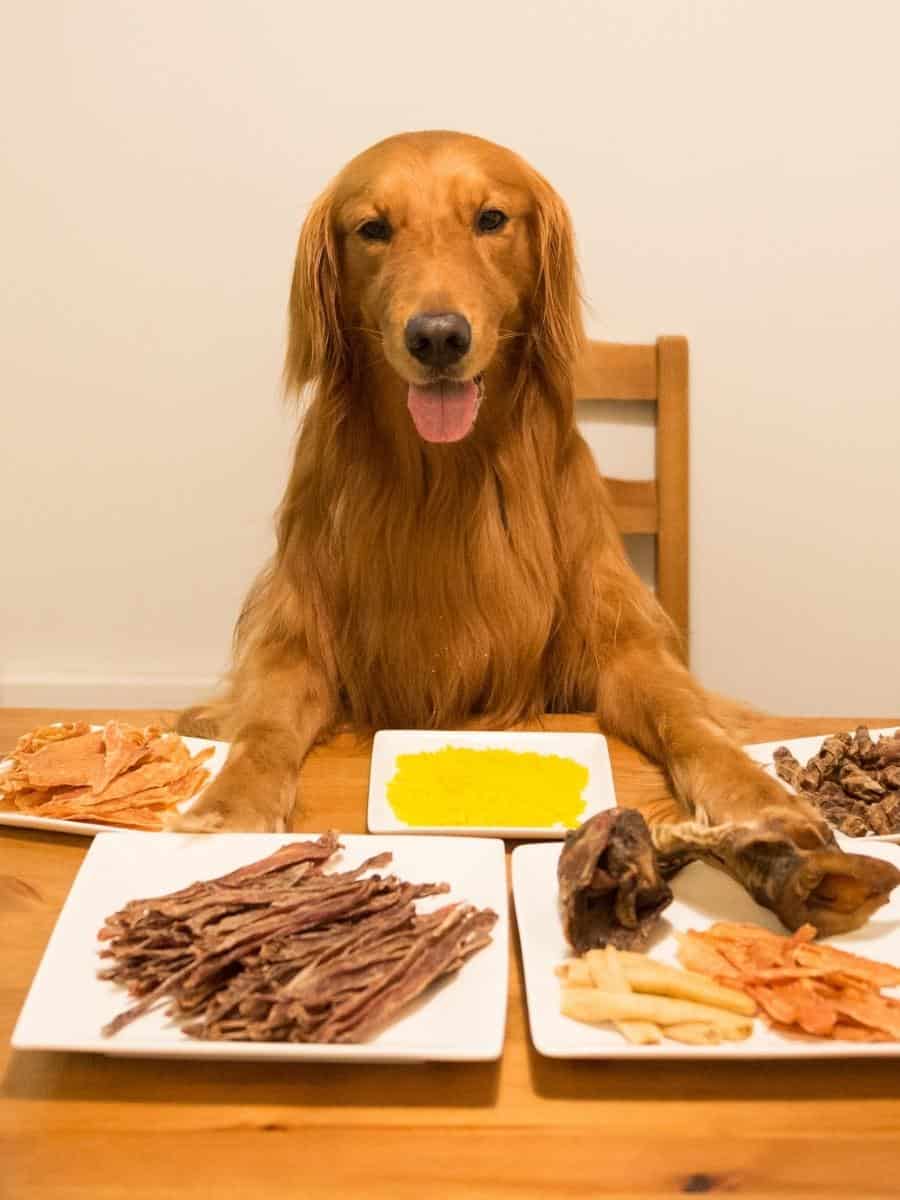
The exact nutritional requirements will depend on many factors, such as the stage of life, breed, size, level of activity, and overall dog health.
For example, an energetic and growing puppy may need twice the calories of an adult dog of the same breed. Elderly dogs may need 20% fewer calories than middle-aged dogs.
For instance, my well-exercised dog needs an entirely different diet and nutrition than a toy breed that likes to laze around all day, and a pregnant pooch needs many more calories than that same inactive lap dog.
So, how does the AAFCO define dogs’ specific recognized life stages? They are:
- gestation/lactation (pregnancy and nursing)
- growth (includes puppies)
- adult maintenance
- all life stages
A Golden Retriever diet designed for all life stages means one that meets both the nutritional requirements for growth and reproduction and adult maintenance. This diet is, therefore, suitable for Golden Retrievers of any age.
However, the “all life stage” diet tends to be greater in calories, so choose this diet only depending on your Golden Retriever’s circumstances.
As your dog grows and his body ages, his requirements for nutrients, vitamins, and minerals alter:
For example, if your Golden Retriever is a working dog or very energetic, you may opt for an “all-life” diet due to extra calories and nutritional needs. But if your doggo is senior, relatively inactive, or overweight, then you’d choose an adult maintenance diet.
Learn more about canine nutrition for optimal health…
Foods For Your Golden Retriever
Now you know what nutrients dogs need, but what do Golden Retrievers eat? Is there a best food for a Golden Retriever?
Golden Retrievers can consume a wide variety of healthy and nutritious foods. Proteins – beef, chicken, lamb, pork, and salmon; grains – wheat, oats, corn, and rice; lentils; dairy such as plain yogurt and cheese; vegetables; peas, pumpkin, and carrots; fruits such as apples and berries are just a few examples.
The above are only a few general examples; let’s take a closer look at the main human foods your Golden Retriever can eat. I’ve organized them for you in the tables below, but there are a few caveats you should be aware of, so keep reading!
| PROTEINS | GRAINS |
|---|---|
| Beef | Wheat |
| Turkey | Rice |
| Chicken | Oats |
| Venison | Oatmeal |
| Pork | Rye |
| Lamb | Maize |
| Duck | Corn |
| Kidney | Quinoa |
| Liver | Buckwheat |
| Heart | Barley |
| Fish | Teff |
| Salmon | Amaranth |
| Tuna | Bulgar |
| Mackeral | Spelt |
| Eggs | Millet |
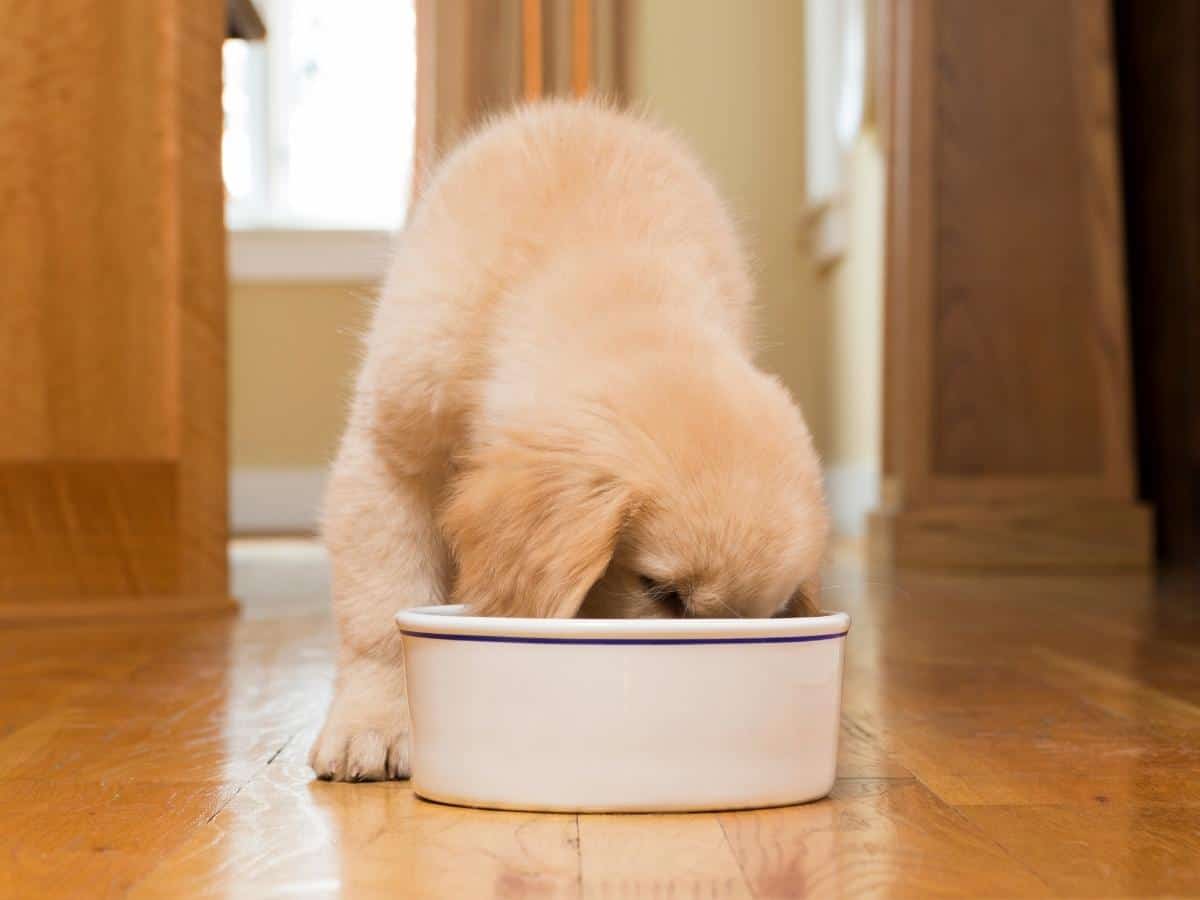
| NUTS | DAIRY |
|---|---|
| Almonds | Cheese |
| Cashews | Cream |
| Peanuts | Milk |
| Chestnuts | Yogurt |
| Hazelnuts | Ice-cream |
| VEGETABLES | FRUITS |
|---|---|
| Artichoke | Apple |
| Asparagus | Apricot |
| Bell Peppers | Banana |
| Beets | Blackberries |
| Broccoli & Brussels Sprouts | Blueberries |
| Cabbage & Cauliflower | Coconut |
| Carrots | Cranberries |
| Celery | Cucumber |
| Corn | Dates |
| Cucumber | Kiwi Fruit |
| Eggplant | Mango |
| Green Beans & Peas | Melon |
| Lettuce & Kale | Nectarine |
| Parsnips | Peach & Plum |
| Pumpkin | Persimmon |
| Potatoes (cooked) | Olive |
| Rutabaga & Turnip | Pear |
| Spinach | Pineapple |
| Sweet Potato | Raspberries |
| Squash | Strawberries |
| Zucchini | Watermelon |
So, here are the caveats to feeding the foods mentioned above:
- Meats should be as lean as possible, with all fat removed. Processed foods, such as bacon and sausage, are high in salt (sodium) and seasoning, so avoid them.
- To aid digestion, you should cook most vegetables first, but sweet potatoes, raw carrots, and green beans are perfect. For more info on veggies for dogs, check out this post: 28 Vegetables Golden Retrievers Can Eat?
- You should remove pits and seeds from fruits because they pose a choking risk. They also contain cyanide, which is dangerous to dogs if ingested in significant amounts. You may like this article, What Fruits Can Golden Retrievers Eat? to learn all the safe fruits for your doggo.
- Don’t feed raw eggs or raw fish because of the risk of salmonella or listeria.
- Nuts aren’t a good idea because of their high fat levels. They can cause nausea and diarrhea and are a choking risk.
- If your Golden Retriever is lactose intolerant, avoid dairy foods.
Foods To Be Avoided
A variety of foods are toxic to dogs (some contain taurine) and can have severe consequences if consumed. Even a tiny amount of poisonous food can cause death in some cases. If your Golden Retriever ingests these foods by mistake, you should seek urgent veterinary help. So, what foods are off-limits?
Golden Retrievers should not eat chocolate, macadamia nuts, onions, garlic, raisins, bread dough, and xylitol-sweetened products. These are the most popular foods that have resulted in dog poisoning in recent years. Other examples include raw potatoes, moldy food, salt, and caffeine.
Read more: What Foods are Toxic to Golden Retrievers?
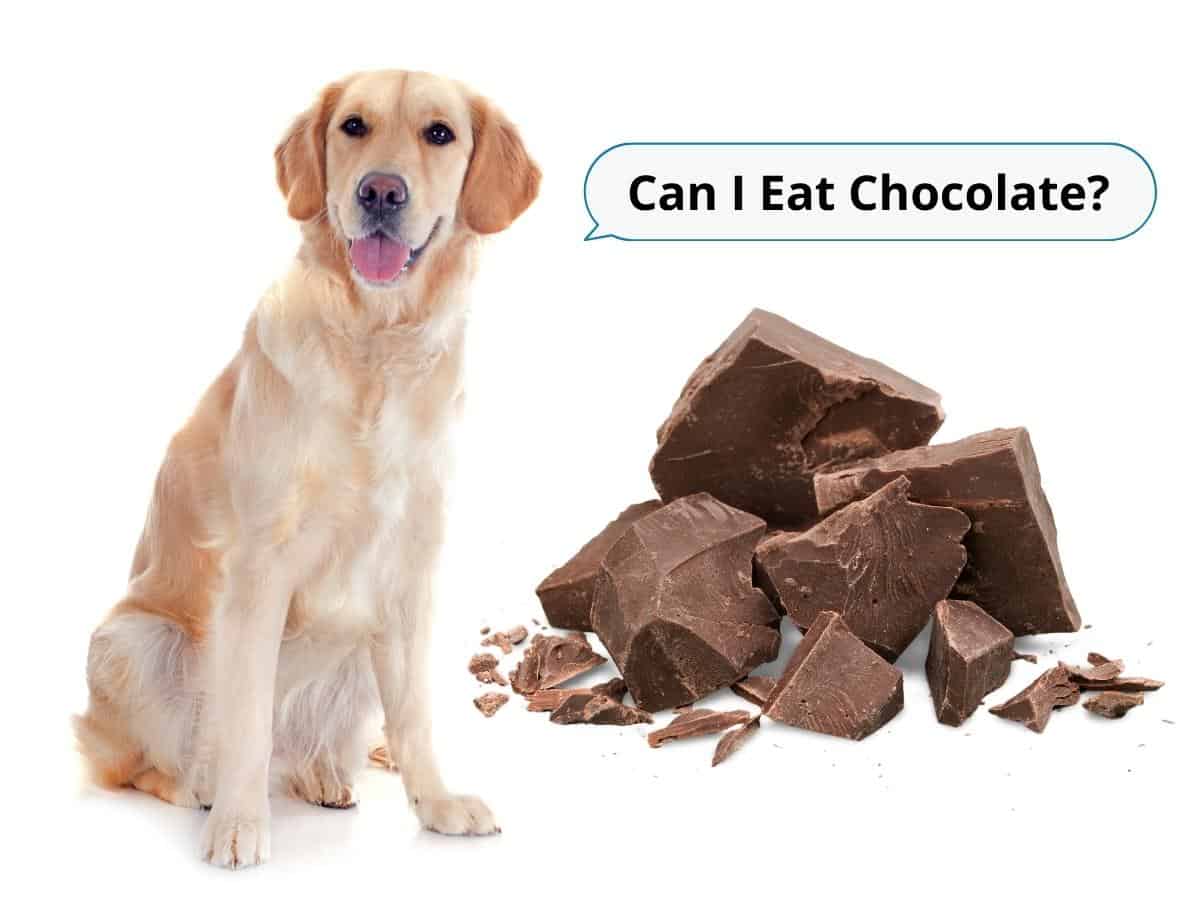
I can’t imagine someone giving a swig of beer, a margarita, or some candies to their Golden Retriever! Poisoning episodes in dogs are often caused by a lack of public awareness about the food or by pets having unintentional access to it.
Key Foods that Golden Retrievers Should Not Eat…
| Alcohol | Grapes | Garlic |
| Chocolate | Cocoa | Caffeine |
| Hops | Conkers | Macadamia nuts |
| Candies | Rhubarb Leaves | Onions |
| Leeks | Chives | Raisins |
| Nutmeg | Wild mushrooms | Cherries |
| Xylitol | Yeast dough | Black walnuts |
| Starfruit | Raw Potatoes | Salt |
| Avocado | Tomatoes (green) | Rotten food |
If you’re worried that your Golden Retriever has eaten something toxic, the Pet Poison Helpline is a great place to start. It has a long list of foods, poisonous plants, household products, and medications you can check if you’re unsure whether something is dangerous.
You should also call your vet, as the quicker you treat pet poisoning, the easier and safer it is to treat.
Recommended Types of Dog Food
We all want what’s best for our dogs, and we like them to eat the best food possible to keep them happy and healthy.
People typically feed their Golden Retriever either dry food (kibble) or canned wet food, but there are several different kinds of dog food, and it can be daunting knowing where to start.
So, what type of dog food is best for Golden Retrievers?
The best type of dog food for Golden Retrievers is dry food, such as kibble or cold-pressed. Dry food is more practicable for medium-large breeds, provides more nutrients per bite than wet food, and is less costly.
Having said that, depending on your Golden’s needs, fitness, health, and lifestyle, you should choose the diet that best suits him. You must, however, also meet your own needs and beliefs.
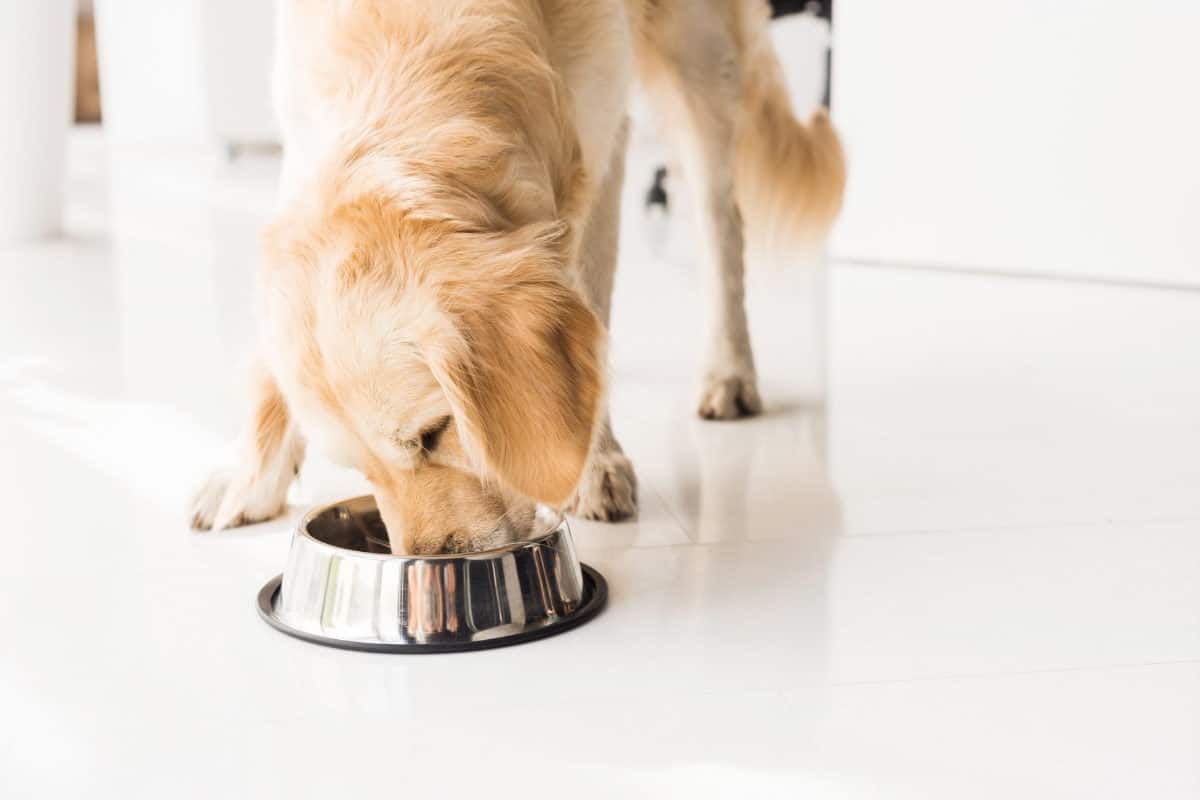
Most Popular Types of Dog Foods to Feed Your Golden
| Complete Dry Foods | Canned Wet Foods |
| A Mix of Dry and Wet | Home Produced Diet |
| Complete Raw Diet | Dehydrated and Freeze-Dried |
If you choose commercial dog food, ensure it is COMPLETE and BALANCED, according to AAFCO guidelines. This means that the food must contain all of the requisite nutrients in their appropriate proportions.
The AAFCO also offers detailed instructions on reading and understanding dog food labels. There are a lot of particulars here, but the following are the things to look for:
- The food’s ingredients should be specified in descending order of weight predominance on the packaging.
- Relevant nutrient details should be prominent.
- Feeding instructions must be provided.
Therefore, when selecting dog food, you should check the ingredients AND the food’s nutritional content. All dog food should also display “The Nutritional Adequacy Statement” for the life stage the product is suited for.
This statement is intended to help dog owners, veterinarians, and nutritionists determine the nutritional value of their pets’ food. If you want to feed your Golden Retriever a dry or wet food diet (or a combination), always review the package to ensure that it meets all of your Golden’s requirements.
Premium protein sources (beef, poultry, lamb, pork, fish, etc.), as well as high-quality grains, vegetables, fruits, fiber, and fats, should be prioritized, as well as essential vitamins and minerals.
Superior dog foods will also include additional protein sources, such as eggs and plant-based proteins, such as vegetables, grains, and legumes.
In the next section, we’ll look at the various types of food you can feed your Golden Retriever. This information will help you to decide what kind to feed your dog.
Dry Foods
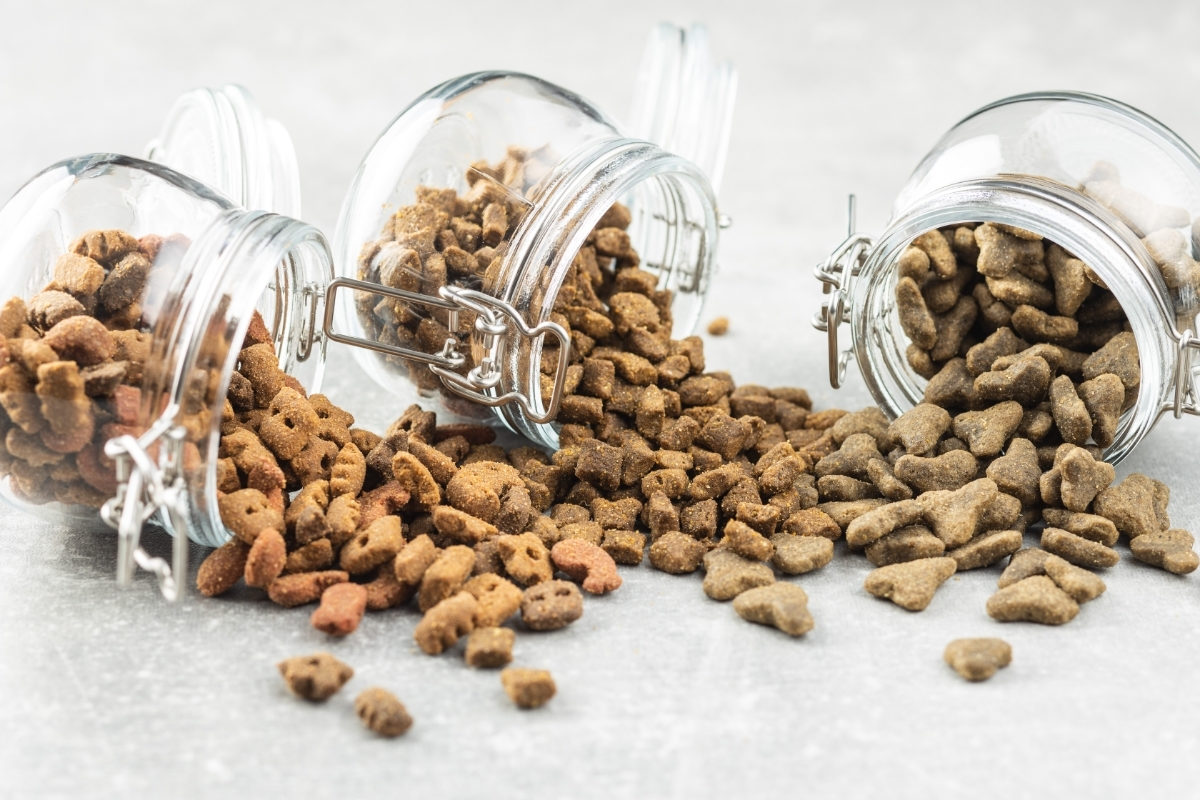
One of the most popular types of dog food is dry food. Complete dry dog food comes in two varieties. These are KIBBLE and COLD-PRESSED dog food, respectively.
So what exactly is kibble? Kibble is essentially ground-up ingredients shaped into various shapes and sizes of pellets. It’s made either through extrusion or oven baking under high pressure or temperatures.
All kibble is produced similarly by using the same kind of machinery. Even premium kibble made with the best quality ingredients uses the same process.
What is cold-pressed dog food?
Cold-pressed food is a higher-quality kibble because it’s prepared using a unique cooking method. The food is produced at a much lower temperature and cooked faster to retain higher nutritional value, vitamins, and flavor before being pressed into different shapes.
It is widespread in the United Kingdom and Europe and is becoming more popular in the US and other regions.
Here are the main points to consider when contemplating feeding your doggo dry food:
- Since kibble and cold-pressed food contain less moisture, they have more nutrients per bite than wet food. This means you won’t have to feed your Golden Retriever as much to keep him happy.
- When comparing dry food to wet food, dry food is less expensive per meal and can result in less waste because it can be left in your dog’s dish for longer periods, while you must return wet food to the refrigerator.
- Dry food can also aid Goldens with dental issues because it helps clean their teeth and gums.
- For a medium-large dog, such as a Golden Retriever, dry dog food is the most sensible option; however, kibble and cold-pressed dog food come in all shapes and sizes, so smaller breeds can choose from a smaller range.
Pro Tip! Dry food may be fed completely dry, or you can occasionally soften it and make it into a tasty “gravy” by adding warm water. Some owners also like to add a topping to their Retriever’s food, such as cooked meats, fish, or vegetables, which is precisely what I do with my dog’s diet.
However, this isn’t needed if you choose a good quality brand. My dog also loves tuna, which leaves her coat and skin looking lustrous and healthy and reduces shedding.
When I add a topping, I reduce the amount of dry food she eats marginally to prevent her from gaining weight.
Canned Wet Foods
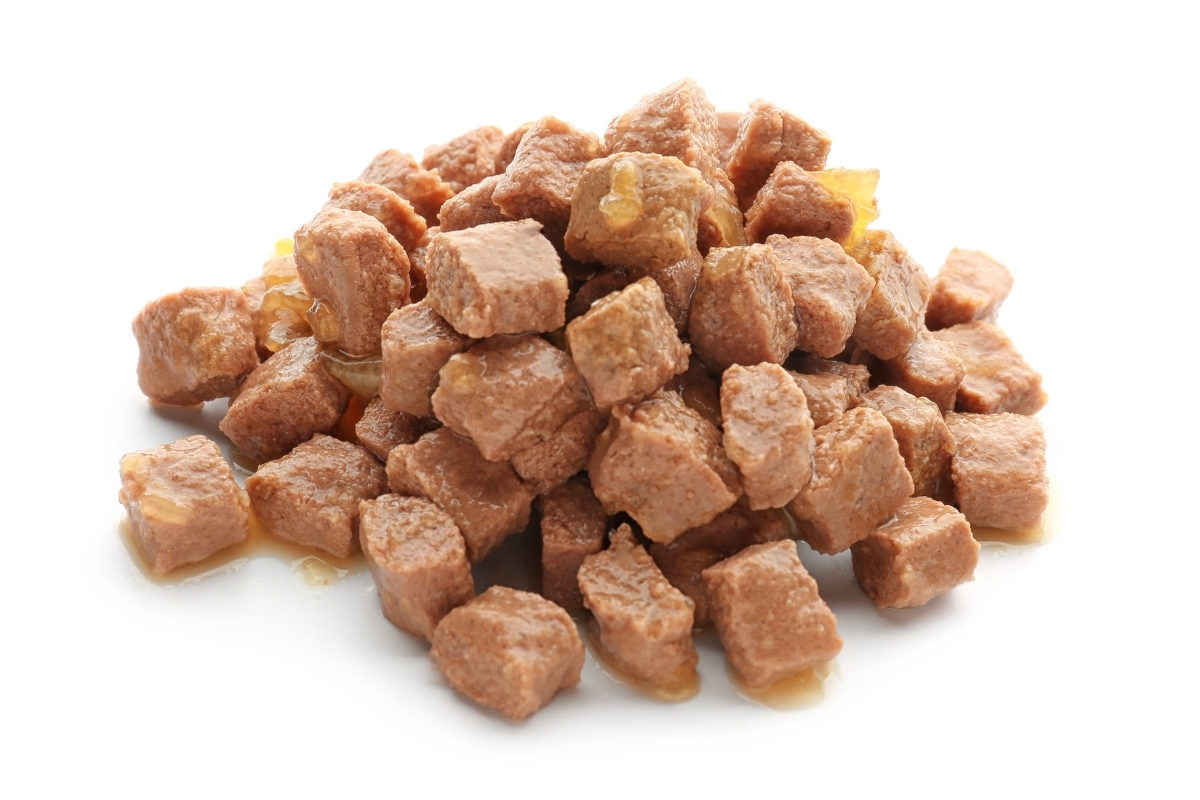
Canned wet dog foods contain around 75% moisture, whereas dry foods have about 10%. As a result, the higher the water content, the fewer nutrients, so your Golden Retriever will need to consume more to get all the nutrition he needs.
Here are some things to know about wet dog food:
- Not every brand of canned food provides enough protein for your Golden Retriever. You should avoid low-quality wet foods since they commonly use thickeners such as wheat flour, white/brown rice, or other grains.
- A wet diet may be more costly, especially if your dog is the size of a Golden, but it may be ideal if your dog enjoys eating a more significant portion. A wet diet may also be preferable for smaller breeds.
- If your dog is a picky eater or you have a senior Golden Retriever with a reduced appetite, wet food might be a better selection.
You can also buy semi-moist dog foods. However, these are not as popular as they offer the least nutritional value and can be expensive.
Unfortunately, dog food manufacturers incorporate sugar and salts to extend the shelf life of their products and take advantage of toxic by-products. Artificial colors, chemical preservatives, and chemical flavor enhancers are commonly found in semi-moist foods.
A semi-moist diet may not be suited to your Golden Retriever, especially if he is on the heavy side and needs to lose a few pounds.
On the other hand, if your Golden Retriever has trouble digesting other food types, semi-moist food might be the best option. If he is a picky eater, he will appreciate the meaty flavor and find this kind of food more appealing.
If you’re thinking of feeding your Golden Retriever a semi-moist diet, consult your veterinarian to determine how many calories he needs and the best way to feed him.
Alternatively, if your dog is suffering from obesity, these commercial foods are formulated for this type. Try to head on to a pet shop to source the best dry dog food with perfect dog food ingredients. Well, there are wet versions too.
A Mix of Dry and Wet
Some dog owners combine dry and wet foods in their dog’s diets. The foods may be mixed or alternated at each meal. For example, wet in the morning and dry in the evening (or vice-versa).
I’ve even heard of Retriever owners who, while feeding dry food, use wet food as a topping in their dog’s bowl.
If you take this approach, it’s safer to stick with the same brand if you’re combining the two to ensure you’re not raising your dog’s calorie intake and, as always, seek clinical guidance to ensure your Golden is getting the proper nutrition.
Home Produced Diet
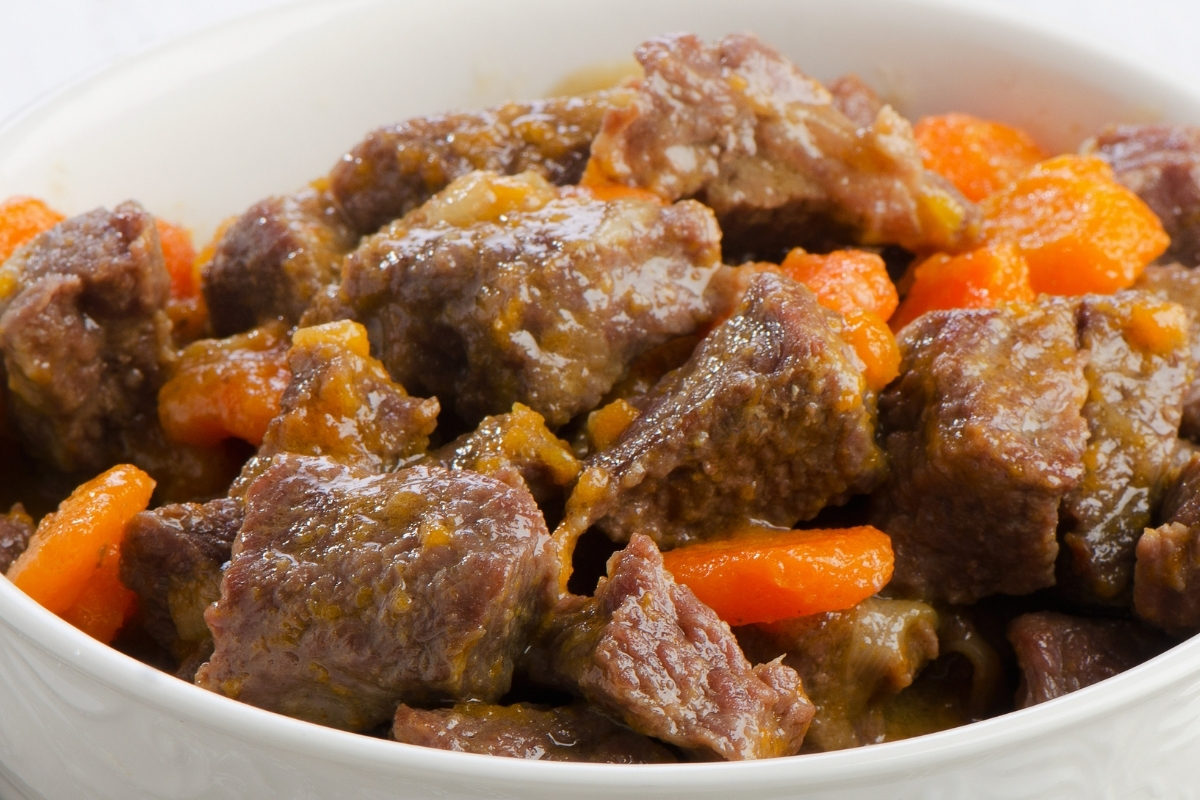
Some owners like to feed their Golden Retriever a home-produced diet (referred to as home-feeders). Because of the ease and variety of dry and wet dog foods, I wondered why anyone would want to be a home feeder.
Here are the main reasons people choose to feed a home-produced diet:
- Home feeders sought alternatives to commercial pet foods as they were worried about the nutritional value of the ingredients used.
- Home feeders enjoyed the process of preparing the food and strengthening the relationship with their dog or satisfying their opinions.
- Home feeders fear their dogs will merely not like or refuse to eat commercial dog food.
- A home-prepared diet may be essential to help with a diagnosis (e.g., for a food elimination trial) or if a dog has several diseases for which no commercial diet exists.
- Home feeders sought comfort for dogs with chronic or terminal illnesses.
There are several drawbacks to making dog food at home. It is possible, but it will take a lot of effort and hard work, and it may end up costing more than the highest-quality dog food available.
Homemade diets can provide total nutrition. However, you need to make sure your Golden Retriever gets the correct balance of protein, fats, carbohydrates, minerals, and vitamins, and this is not easy to do every day.
It’s best to consult your veterinarian before preparing a home-cooked diet for your dog.
Professional pet nutritionists accredited by the American College of Veterinary Nutrition can also help you customize a balanced diet for your Golden Retriever. Here is their directory that you may find helpful.
You should cook all animal products to kill bacteria that could make your Golden sick – unless he’s accustomed to a raw diet. You should also cook vegetables and grains for easier digestion. Feed a grain-free diet only if your dog is allergic to grains.
My final thoughts about whether or not to feed your dog a homemade diet are as follows:
- Do you have the time to prepare your Golden Retrievers’ daily meals?
- Your dog will need routine health tests ensuring that he does not lack any nutrients.
- Many high-quality commercial dog foods on the market meet all your dog’s nutritional needs.
Raw Food
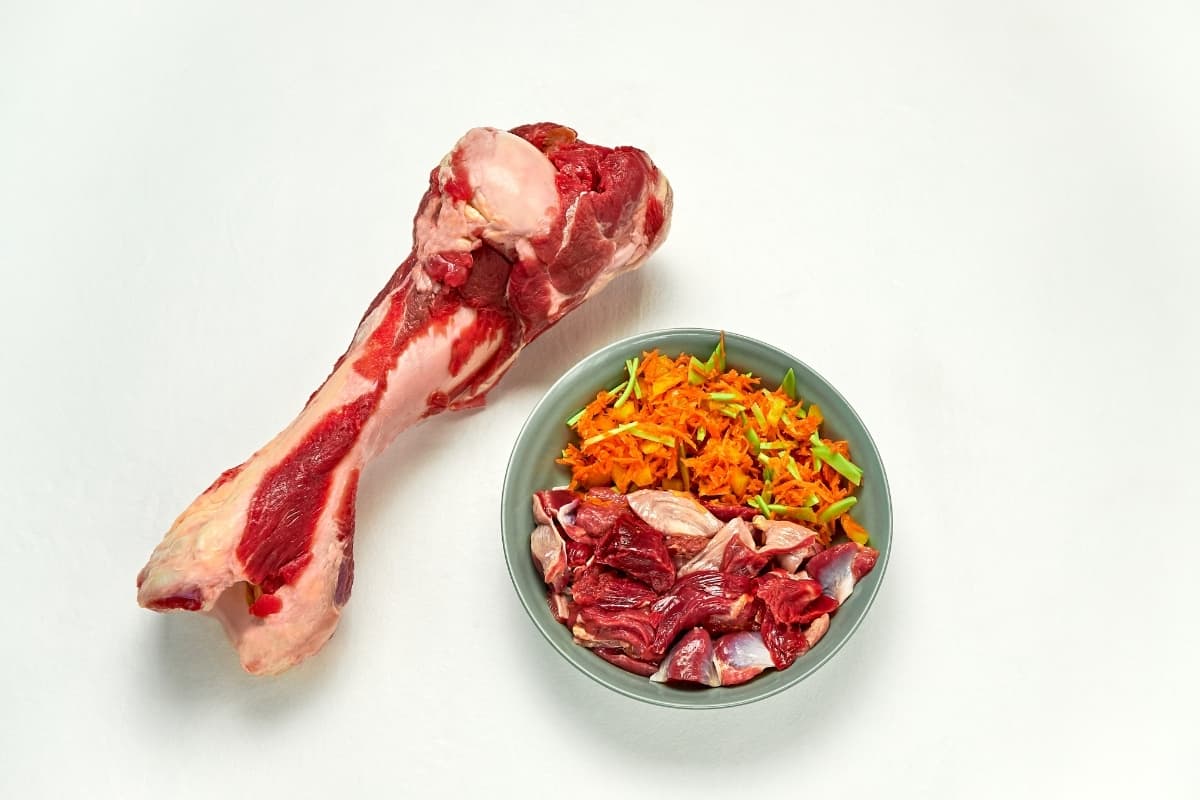
It’s okay to start feeding your Golden Retriever puppy raw food after he’s three to four weeks old. Raw feeding is controversial, but it’s based on the idea of feeding dogs a diet they would have eaten in their natural environment before domestication.
While sled dogs and racing greyhounds have long eaten a raw food diet, there is a trend that surfaces now and again for feeding dogs an all-raw diet that includes raw meat, fish, eggs, vegetables, fruit, and some dairy.
Raw Feeding Guide
When determining whether or not to feed your Golden Retriever raw dog food, there are two crucial things to remember.
- The first is to ensure your dog has a well-balanced diet that includes all the nutrients he needs to stay healthy and disease-free. When feeding a growing puppy, this is especially necessary.
For example, homemade raw diets can be challenging because you must ensure that you are not under or overfeeding essential nutrients. This is especially vital if your Golden Retriever is sick, pregnant, or nursing and has different nutritional needs.
- Food safety concerns about bacterial or parasitic infection in raw meat (animal protein) are the second most crucial issue. When feeding raw foods to dogs, food poisoning is a significant concern.
If you’re thinking of feeding your Golden Retriever a raw food diet, ensure you’re well-versed in the appropriate handling of raw foods and all food safety concerns.
Many raw-feeders believe that eating a raw diet has numerous health benefits, including increased energy, improved digestion, a shinier coat, better skin, cleaner teeth, and overall healthier life.
However, there have been insufficient studies to measure the risks or benefits of feeding dogs a raw diet. Therefore, most believed benefits of feeding raw foods remain speculative.
Nonetheless, according to this study, there is enough evidence to compel vets to discuss the human health consequences of raw food diets with pet owners and the risk of disease to the pet.
The American Veterinary Medical Association also discourages pet owners from feeding dogs raw or unprocessed meat and eggs due to the risk of disease:
As I would like to take a balanced view of this subject, I have to point out that advocates of raw food diets say that commercially processed dog food can also contain harmful bacteria.
They argue that the whole “bad bacteria” issue is greatly exaggerated as long as proper hygiene procedures are followed.
If you choose to feed your Golden Retriever a raw diet, you can do so at home or buy commercial raw foodstuffs. These include whole foods, usually frozen or freeze-dried, which brings me nicely to the next topic.
Dehydrated and Freeze-Dried
You can feed your Golden Retriever a dehydrated or freeze-dried diet; both have become increasingly common in recent years.
These diets are similar in that they extract moisture from the food to preserve it and eliminate the need for artificial preservatives, but they vary in several ways.
Dehydrated foods. These are partially cooked at low temperatures to extract most of the water. The food is heated but not fully cooked, so nutrients and enzymes remain whole. They are a complete diet and are frequently seen as a step up from ordinary extruded kibble.
To make it edible, you need to add warm water to dehydrated dog food. As a result, the food has a texture comparable to canned wet food but is much less refined. These foods are easy to store, and prepare, and have a long shelf life because they do not need refrigeration.
A dehydrated diet is also a good option if your Golden has a sensitive stomach, as the food is easier on the digestive system due to the gentle cooking method.
Freeze-dried foods. In a nutshell, freeze-dried foods are essentially a repackaged raw diet.
The raw ingredients in freeze-dried dog food are frozen, and then placed in a vacuum to turn the moisture into vapor. After that, the food is sealed in an airtight container. Unlike a true raw diet, this method reduces the number of bacteria such as salmonella.
Although freeze-dried food looks like kibble and does not need to be rehydrated before eating, your Golden Retriever will find it more palatable and digestible if some water is added first.
They are generally very high protein diets with fruits and vegetables occasionally added. Freeze-dried is an excellent alternative if you want to feed a raw diet but don’t like to handle raw food but want to provide a healthier and less processed diet.
You can also incorporate freeze-dried into your Goldens’ diet by combining it with other types, such as kibble or wet.
Freeze-dried foods are more expensive than regular kibble, but as the food has the most moisture removed, they are more nutritionally dense, so you feed your Retriever less.
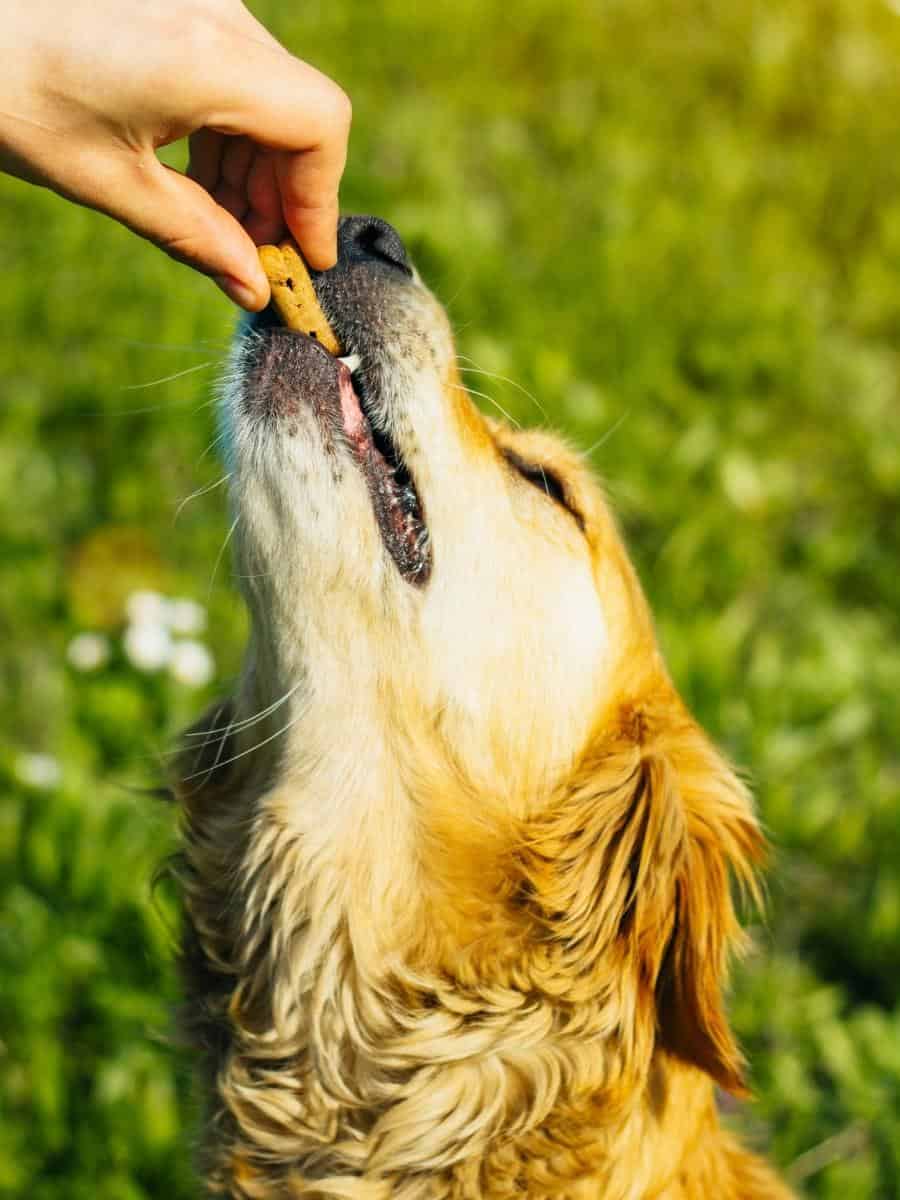
Pros and Cons of Different Types of Dog Food
To help you decide on the best diet for your Golden Retriever, here’s all the above information in handy tables for you to easily visualize the pros and cons of each food type:
| DRY DOG FOOD | WET FOOD (including semi-moist) |
|---|---|
| More practicable for medium-large breeds | More suited for small or toy breeds |
| Inexpensive and less waste | Some dogs find wet more palatable than dry foods |
| Denser. Provides more nutrients per bite than wet | More suited to picky and senior dogs |
| Convenient and easy to feed | Good for hydration |
| No need to worry about nutritional deficiencies | No need to worry about dietary deficiencies |
| Does not require refrigeration | Dogs can enjoy a larger portion per meal due to the high water content |
| Ideal for “grazers” as it can be left in the bowl longer | Suitable for dogs who have trouble chewing |
| Can add “toppings” such as cooked meats, fish, or veg for added variety | Semi-moist may be ideal for dogs that find foods difficult to digest |
| You can add water to make a tasty gravy | It has a longer shelf life, but there can be more waste if the food is uneaten |
| Comes in many shapes and sizes | More expensive than dry foods |
| Great for interactive feeders | Semi-moist contains added salt and sugar |
| Good for the teeth | May contribute to gum disease |
| Poor-quality brands often add “fillers” and poor-quality ingredients | Poor quality brands often add “fillers” and low-quality ingredients |
| MIX of DRY & WET | HOME PRODUCED |
|---|---|
| You get the best of both dry and wet | You are in control of your dog’s food and nutrients |
| Can mix in the same bowl or at separate feeds | May suit picky eaters |
| Provides variety | Can help increase bonding |
| Recommended to keep to the same brand | Can assist with a medical diagnosis or healing |
| Need to track calorie intake | Expensive and time-consuming |
| May require the advice of a vet | Regular health checks are advised to ensure correct nutrition |
| RAW | DEHYDRATED & FREEZE-DRIED |
|---|---|
| You control your dog’s food and nutrients | Most of the moisture is removed |
| Need to ensure proper nutrition is provided | No preservatives are added |
| May be unsuitable for sick or senior dogs | Nutrients remain intact |
| Risk of food contamination | Freeze-dried is fundamentally raw |
| No proven health benefits except for better digestion | Long shelf life and easy to store |
| Expensive and time-consuming if preparing at home | Convenient |
| Regular health checks recommended | More expensive |
Before transitioning your Golden Retriever from one type of food to another, I recommend you talk to your veterinarian about the individual benefits and risks.
Exactly How Much To Feed
Once you have settled on the type of diet to feed your dog, you now have the next hurdle! How much food should your Golden Retriever eat?
The amount of food Golden Retrievers need depends on their age, whether a puppy, adult, or senior. Activity level, overall health, serious illness, pregnancy, or nursing can also increase a dog’s energy needs. The key is ensuring you don’t overfeed or underfeed your dog.
Don’t worry; if you’re feeding commercial dog food, the packaging should indicate the recommended feeding guidelines for your Retriever’s age. On their websites, most brands often have valuable tables or calculators.
These must indicate how much food to offer per the dog’s weight, but you must also consider your dog’s activity level. Inactive dogs, for example, may need 10% less than what is recommended on the food label, while energetic dogs may need 20% to 40% more.
Golden Retriever feeding chart by age
| Age | Meals Per Day | Amount Per Meal |
|---|---|---|
| Puppy (0-4 months) | 4 | 1/4 – 1/2 cup |
| Puppy (4-6 months) | 3 | 1/2 – 3/4 cup |
| Puppy (6-12 months) | 2 | 3/4 – 1 cup |
| Adult (1-7 years) | 2 | 1-2 cups |
| Senior (7+ years) | 2 | 1/2-1 1/2 cups |
Suppose you want to feed a homemade diet, raw or a combination of dry and wet. In that case, as mentioned above, you can contact your veterinarian or a pet nutritionist to ensure your Golden Retriever is getting the necessary nutrients and calorie intake.
Feeding Frequency for Puppies
Growing puppies have different nutritional requirements than adult dogs, requiring more frequent feedings at varying stages of development. Depending on age, here’s how much you should feed your Golden Retriever puppy:
| AGE OF GOLDEN RETRIEVER PUPPY | DAILY MEALS |
| 6 to 12 weeks | 4 |
| 12 to 24 weeks | 3 |
| 24 weeks onwards | 2 |
Golden Retriever puppies get all their nutrients from their mother when they are born. However, starting the weaning process onto a new diet from three to four weeks old is safe.
Puppies in the early stages of development need enough calories, protein, fat, vitamins, and minerals to support rapid growth and development and set them on the road to a healthy life.
Learn More On How Often Dogs Should Eat In This Video…
Since Golden Retrievers are a medium-large breed, they should be fed large-breed dog food – even puppies. Large-breed dog food is essential for your puppy’s nutrition.
But why?
Large-breed foods have a higher protein content and lower calcium, phosphorus, and fat content. It is nutritionally designed to keep puppies from growing too quickly, leading to debilitating conditions like hip and elbow dysplasia.
While adult dogs can thrive on one meal a day, most Golden Retriever owners feed their dogs twice daily. It makes it easier for the dog to digest the food, control hunger, and avoid life-threatening bloat (GDV). My dog would much rather eat twice a day.
FAQs
What Treats Can I Give my Golden Retriever?
The best treats for Golden Retrievers are those made with high-quality, nutrient-dense ingredients and low in calories and fat. Artificial preservatives, colorings, or additives should not be used in dog treats. As an alternative, you can feed nutritious fruits and vegetables.
Can Golden Retrievers Eat Bones?
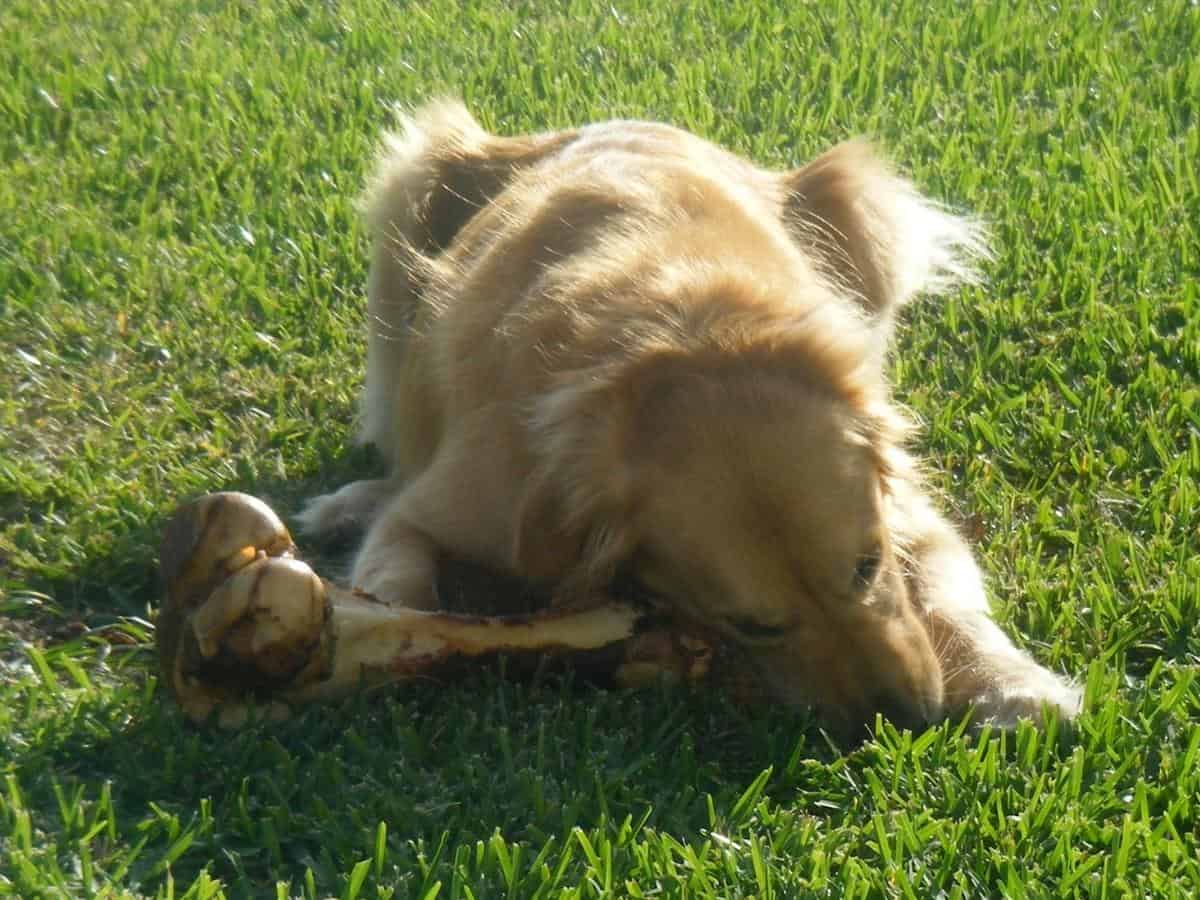
Golden Retrievers can eat bones. They are high in nutrients, especially calcium and phosphorus, and can help clean and strengthen your dog’s teeth.
On the other hand, cooked bones must never be fed, as they can splinter and cause injuries or choking. The bone must also be larger than your dog’s muzzle, such as a beef shank bone.
Are Golden Retrievers Carnivores?
Golden Retrievers are not carnivores but omnivores. While protein makes up most of a dog’s diet, the domesticated dog can digest and use plant-based foods for essential nutrients.
They also have blunt molars capable of grinding up fibrous plants and intestines that can digest non-meat foods.
How Much Water Should Golden Retrievers Drink?
Golden Retrievers should drink up to one ounce (30 ml) of water daily for each pound they weigh. However, there are many other variables to consider, such as age, activity level, diet (wet food contains a lot more water than dry), temperature and humidity, medication, pregnancy, nursing, etc.
Ensure your dog’s water bowl remains full and the water is changed every few hours or invest in a dog water fountain.
Giving ice cubes, adding water to dry food, or making fun playtimes with a hose in warm weather are other ways to keep your Golden Retriever hydrated.
Final Thoughts – The Importance of Nutrition
Many pet food companies have spent millions of dollars studying which ingredients have the highest levels of nutrients to achieve a nutritious, balanced diet that will help strong puppy growth and mental and physical development.
You must do your due diligence and select the best diet for your Golden Retriever. As for supplements, there’s no reason to feed them if your dog eats a complete and healthy diet unless a veterinarian recommends them.
So here’s my best piece of advice:
Choose a diet appropriate for your Golden Retriever’s age, lifestyle, and beliefs – and invest in the highest-quality dog food you can afford.





